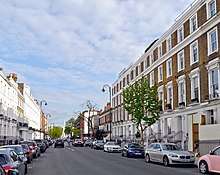Oakley Street, Chelsea
Oakley Street is in the Royal Borough of Kensington and Chelsea, London. It runs roughly north to south from King's Road to the crossroads with Cheyne Walk and the River Thames, where it continues as the Albert Bridge and Albert Bridge Road. The street was named after Baron Cadogan of Oakley.[1][2]

History

Much of the street is on the site of the former Winchester House, the one-time residence of the Bishops of Winchester in London who had bought the 17th-century part of Chelsea Place from Charles Cheyne in 1664 after the destruction of Winchester Palace in the English Civil War.[3] In 1821, after the house fell into disrepair, the bishop successfully sought an Act that allowed him to sell the house and its ground of 2.5 acres to the trustees of the Cadogan Estate. In 1825, the trustees obtained a further Act to demolish the property and build new houses on the site. Demolition was complete by 1836, but the site was still vacant in 1847. By 1850, there were ten houses at the northern end, and four at the southern by 1851.[4]
Notable buildings

Numbers 1–11, 14–25, 26 and 27, 28–35 and 101–108 Oakley Street are listed grade II on the National Heritage List for England.[5][6][7][8][9]
Notable residents
No. 2 was owned by John Samuel Phene, a noted property developer and local eccentric.[2][10][11]
No. 29 was lived in by Donald Maclean, one of the Cambridge Five spy ring, in the latter 1930s.[2][12]
No. 42 was where Bob Marley moved to with his wife Rita in January 1977, following an attempt on his life in Jamaica.[13]
No. 56 was the home of Antarctic explorer Robert Falcon Scott from 1904 to 1908, together with his mother and sister.[14][15]
No. 74 was home to actress Dame Sybil Thorndike and her husband Lewis Casson in the 1930s.[16][17][18]
No. 87 was home to Oscar Wilde and his mother Jane Wilde, and many years later, the footballer George Best.[19]
No. 89 was the home of David Bowie from 1973 to at least 1976.[19][20][21]
No. 93 was home to suffragettes in 1911, who refused to complete the 1911 census on the grounds of "no vote no census".[22] However, the enumerator was able to confirm from the neighbours that the head of the house was Mrs Alice Monck Mason, who lived there with her daughter, Winifred Alice Monck Mason (and others), an actress who went by the name of Winifred Mayo.[22]
Gallery
 Winchester House by Thomas Hosmer Shepherd[23]
Winchester House by Thomas Hosmer Shepherd[23] 1868 Ordnance Survey map[24]
1868 Ordnance Survey map[24] Oakley Street, c.1930.
Oakley Street, c.1930. No. 42, briefly the home of Bob Marley after an attempt on his life
No. 42, briefly the home of Bob Marley after an attempt on his life No. 56, former home of Robert Falcon Scott[14]
No. 56, former home of Robert Falcon Scott[14] No. 87, former home of Oscar Wilde and later George Best
No. 87, former home of Oscar Wilde and later George Best No. 89, former home of David Bowie in the 1970s
No. 89, former home of David Bowie in the 1970s No. 93, where suffragettes refused to answer the census in 1911
No. 93, where suffragettes refused to answer the census in 1911
References
- "Cadogan Estate" in Christopher Hibbert; Ben Weinreb; John Keay; Julia Keay (2008). The London Encyclopaedia (3rd ed.). London: Pan Macmillan. p. 119. ISBN 978-0-230-73878-2.
- "Simon's Walks", At Home Inn Chelsea.
- Landownership: Chelsea manor. British History Online. Retrieved 28 March 2018.
- "Settlement and building: From 1680 to 1865, Chelsea Village or Great Chelsea". Victoria County History. Retrieved 27 March 2018.
- Historic England. "1–11, Oakley Street SW3 (1266229)". National Heritage List for England. Retrieved 26 March 2018.
- Historic England. "14–25, Oakley Street SW3 (1225689)". National Heritage List for England. Retrieved 26 March 2018.
- Historic England. "26 and 27, Oakley Street SW3 (1266230)". National Heritage List for England. Retrieved 26 March 2018.
- Historic England. "28–35, Oakley Street SW3 (1225690)". National Heritage List for England. Retrieved 26 March 2018.
- Historic England. "101–108, Oakley Street SW3 (1225691)". National Heritage List for England. Retrieved 26 March 2018.
- "Dr John Samuel Phene | 2 Oakley Street, Chelsea, London", Notable Abodes.
- Dave Walker, "Dr Phene in his garden", The Library Time Machine, The Royal Borough of Kensington and Chelsea.
- Roland Philipps, A Spy Named Orphan: The Enigma of Donald Maclean, Bodley Head, 2018, p. 69.
- Robert L (11 May 2016). "15 places in London with a Bob Marley connection". Time Out London. Retrieved 28 March 2018.
- "Captain Robert Falcon Scott". www.rbkc.gov.uk. Retrieved 28 March 2018.
- "Scott, Robert Falcon (1868–1912) – English Heritage". www.english-heritage.org.uk. Retrieved 28 March 2018.
- "People at Home ". Oakley Street Residents' Association.
- John Costella, From Battersea to the Tower: Exploring Londons Thames Path, AuthorHouse, 2010, p. 23.
- Jonathan Croall, Sybil Thorndike: A Star Of Life, Haus Publishing, 2008.
- Melanie Backe-Hansen (6 April 2016). "A place in history: Oakley Street". The London Magazine. Archived from the original on 27 March 2018. Retrieved 26 March 2018.
- Olivia Waring (11 January 2016). "Everyone is sharing David Bowie's bad ass mug shot from 1976". metro.co.uk. Retrieved 27 March 2018.
- Wendy Leigh (2016). Bowie: The Biography. Simon and Schuster. pp. 137–138. ISBN 978-1-4767-6709-3.
- "The Suffragettes of Oakley Street". house-historian.co.uk. 12 February 2016. Retrieved 27 March 2018.
- Dave Walker, "Shepherd in Chelsea", The Library Time Machine. Royal Borough of Kensington & Chelsea, 2 October 2014. Retrieved 28 March 2018.
- Ordnance Survey map, 1868. Digimap. Retrieved 28 March 2018. (subscription required)
External links
